Cómo cambiar la ubicación de copia de seguridad de iTunes
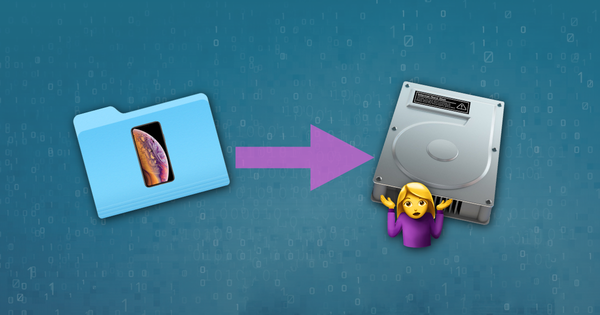
La ubicación predeterminada de la copia de seguridad de iTunes se establece en el disco principal de la PC o Mac, y en macOS 10.15, las copias de seguridad de iOS creadas por Finder se almacenan en el mismo lugar. Muchos usuarios tienen copias de seguridad grandes o copias de seguridad de una serie de dispositivos iOS, y como consecuencia se encuentran con poco espacio en el disco.
Es posible configurar una computadora para que iTunes realice copias de seguridad en un disco duro secundario, o en un disco duro externo o NAS.
En pocas palabras, esto se hace reemplazando la carpeta de copia de seguridad de iTunes con un enlace simbólico a la ubicación deseada. Este es un cambio fácilmente reversible, por lo que es posible restaurar la ubicación de copia de seguridad predeterminada en su directorio original.
Tenga en cuenta que si la ubicación de la copia de seguridad de iTunes se cambia a un volumen que no está disponible en todo momento, el proceso de copia de seguridad de iTunes fallará cuando la nueva ubicación no esté disponible.
Lo que necesitarás
Para cambiar la ubicación predeterminada de la copia de seguridad de iTunes de su computadora, es necesario lo siguiente:
- Competencia media con una PC o Mac
- 10 minutos
- Una comprensión de la nueva ruta de ubicación de copia de seguridad deseada
- Una Mac con MacOS 10.7 o más reciente, o una PC con Windows Vista o más nueva
- El equipo de soporte de Reincubate está a su disposición para ayudarlo y puede asesorar a los clientes sobre cómo hacerlo.
Cambiar la carpeta de copia de seguridad de iTunes iOS automáticamente
La versión gratuita de iPhone Backup Extractor le mostrará automáticamente la ubicación de copia de seguridad predeterminada de iTunes de su computadora, y le permitirá cambiarla.
- Descargar e instalar iPhone Backup Extractor .
- Selecciona
Preferencesdel menú principal. - Seleccionar
Backupsdesde elPreferencesventana![El panel "Preferencias" que muestra las ubicaciones de respaldo The "Preferences" pane showing backup locations]()
El panel "Preferencias" que muestra las ubicaciones de respaldo - Haga clic en el botón
Changepara iniciar el proceso de cambio de la carpeta de copia de seguridad predeterminada de iTunes.
Cambiando manualmente la carpeta de copia de seguridad de iTunes iOS en Windows
- Open the default Backup location in Explorer using the Windows Run command. Press
⊞ Win+Rand the Run window should appear. For Windows 7, 8 and Windows 10 iTunes Apple version, enter%APPDATA%\Apple Computer\MobileSyncand press⏎ Enter. For iTunes Microsoft Store version, enter\Users\[USERNAME]\Apple\MobileSync\Backup, where[USERNAME]is your Windows user name. - La ventana del Explorador que se abre mostrará una carpeta llamada "Copia de seguridad". Este contiene todas las copias de seguridad de iTunes que ya están presentes en la computadora. Para cambiar la ubicación de la carpeta de respaldo, esta carpeta debe cambiarse de nombre, moverse o eliminarse. Como ejemplo, uno podría cambiarle el nombre a "Copia de seguridad (antiguo)".
- Una vez que la carpeta "Copia de seguridad" ha sido renombrada, movida o eliminada, se puede crear un enlace simbólico a la ubicación de copia de seguridad deseada. Para hacer esto, se debe abrir una ventana de Comando. Al mantener presionada la
⇧ Shifty hacer clic con el botón derecho en la ventana deMobileSyncExplorer recientemente abierta, los usuarios verán un menú con la opción "Abrir ventana de comandos aquí" o "Abrir ventana de PowerShell aquí". Haga clic en eso. - Utilice el siguiente comando
mklink /d Backup "[desired-new-backup-path]". Una vez que se haya ingresado este comando, presione⏎ Entery se completará el cambio. - Después de reiniciar Windows, iTunes almacenará sus copias de seguridad en la nueva ubicación.
Cambiando manualmente la carpeta de copia de seguridad de iTunes iOS en macOS
- Inicie la aplicación macOS Terminal. Esto se puede encontrar usando el Finder, en
Applications / Utilities / Terminal. Alternativamente, se puede iniciar usando Spotlight presionando⌘ Cmd+y escribiendo "Terminal" antes de presionar⏎ Enter. - Indique a la Terminal que cambie a la ubicación predeterminada de copia de seguridad de iTunes, ingresando
cd ~/Library/Application\ Support/MobileSyncy luego presione⏎ Enter. - Revela la carpeta de copia de seguridad actual en Finder ingresando
open .y luego presionando⏎ Enter. - La ventana del Finder que se abre mostrará una carpeta llamada "Copia de seguridad". Este contiene todas las copias de seguridad de iTunes que ya están presentes en la computadora. Para cambiar la ubicación de la carpeta de respaldo, esta carpeta debe cambiarse de nombre, moverse o eliminarse. Como ejemplo, uno podría cambiarle el nombre a "Copia de seguridad (antiguo)".
- Una vez que la carpeta "Copia de seguridad" ha sido renombrada, movida o eliminada, se puede crear un enlace simbólico a la ubicación de copia de seguridad deseada. Utilice el siguiente comando
ln -s [desired-new-backup-path] ~/Library/Application\ Support/MobileSync/Backup. Una vez que se haya ingresado este comando, presione⏎ Entery se completará el cambio. - Después de reiniciar la Mac, iTunes almacenará sus copias de seguridad en la nueva ubicación.
Cómo restaurar la carpeta de copia de seguridad de iTunes a su ubicación original
Si ha seguido los pasos anteriores y le gustaría revertir el cambio, el proceso es sencillo:
- Busque la carpeta de respaldo de iTunes .
- Elimine el enlace simbólico de
Backupque aparecerá allí. - Arrastre su carpeta de
Backuporiginal nuevamente, renómbrela si es necesario para que coincida con su nombre original.
¿Otros retos?
Hemos tenido algunos usuarios que ya han movido su carpeta de copia de seguridad de iTunes a otra ubicación, simplemente arrastrándola, y ahora carecen del enlace simbólico necesario para que iTunes pueda ver la copia de seguridad.
Es fácil de resolver esto, y hay dos opciones:
Arrastra la carpeta de vuelta a donde encontraste originalmente. Si lo ha olvidado, debería llamarse
Backupy se encuentra en~/Library/Application Support/MobileSync.Cree un enlace simbólico que apunte a él, de la misma manera que describen las instrucciones anteriores. Si está en esta etapa, debe abrir una Terminal y hacer esto:
cd [location of the folder which now has "Backup" in it] ln -s Backup ~/Library/Application\ Support/MobileSync
Debería ser tan simple como eso.
¿Hay situaciones donde esto no es posible?
Esta técnica funciona en todos los Mac, pero no funcionará en PC con Windows construidas antes de 2000. Antes del lanzamiento de Windows 2000, Windows usaba sistemas de archivos con formato FAT de forma predeterminada , y esos no son capaces de crear enlaces simbólicos. Desde entonces, cualquier compilación de PC con Windows estará usando discos de formato NTFS, y estos admiten enlaces simbólicos muy bien. Si está ejecutando FAT e intenta crear un enlace, es posible que vea este error: Local volumes are required to complete the operation.
Afortunadamente, Microsoft proporciona algunas instrucciones sobre cómo actualizar un disco de FAT a NTFS . Es un poco más técnico, pero es posible.
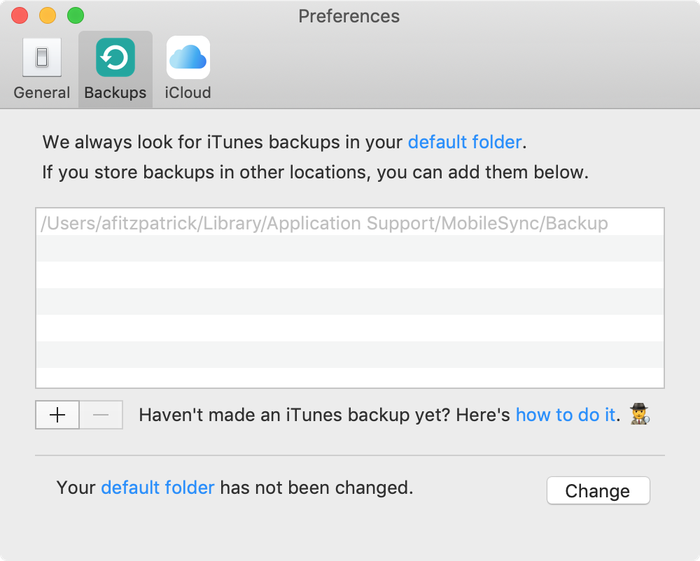
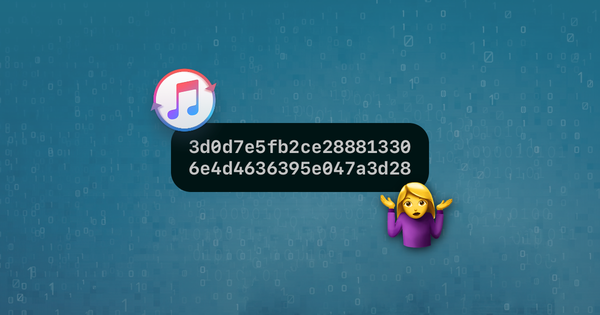

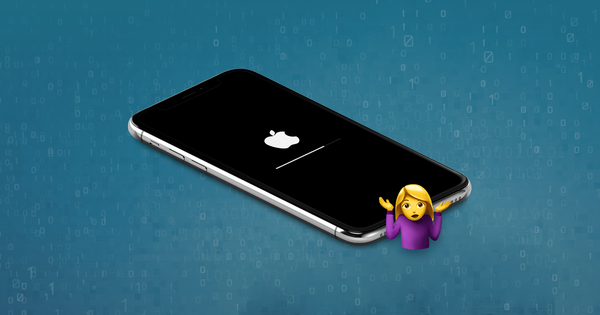
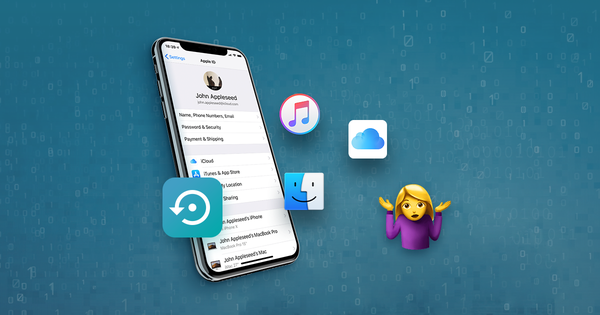

por Gael
Bonjour,
J'essaie tant bien que mal de déplacer ce Backup et de créer un lien symbolique. Cependant, la seule réponse que j'ai est: illegal option -- /
Je vous laisse le chemin que j'utilise et si une âme charitable veut bien m'aiguiller. Merci :)
ln -s/Volumes/VERBATIM\ HD/SAUVEGARDE\ IPHONE/ ~/Library/Application\ Support/MobileSync/Backup ln: illegal option -- / usage: ln [-Ffhinsv] source_file [target_file] ln [-Ffhinsv] source_file ... target_dir link source_file target_file
responder por: Reincubate Support
Salut Gael, merci d'avoir écrit! Le problème ici est l'espace ("") entre votre chemin et les barres obliques.
Il doit s'agir de
ln -s /Volumes/VERBATIM\ HD/SAUVEGARDE\ IPHONE/ ~ /Library/Application\ Support/MobileSync/Backup, et non deln -s / Volumes / VERBATIM \ HD / SAUVEGARDE \ IPHONE / ~ / Library / Application \ Support / MobileSync / BackupFaites-nous savoir si vous avez besoin d'aide! 🙂
por Alex
Backing up to remote Synology server (not local). All you need:
thanks
por Samuel Kwok
Exactly what I needed. I don't want to store on my MacBook as it takes 200GB. This allows me to move to a Time Capsule. I don't use Time Machine but I use Time Capsule as a network drive and another copy of the whole Time Capsule to another network drive.
responder por: Reincubate Support
Glad it helped!
por Rick Galloway
I've got the symbolic link created, but my iPhone back up still goes to the original C: drive location. When I look on my k: drive, I do not see the symbolic link file subdirectory even though it said it was created.
responder por: Reincubate Support
Hi Rick: the symlink should be in your C: drive, in
MobileSync, and calledBackups. It'd be that that points to the K: drive in your case. If you get stuck, why not use the functionality in iPhone Backup Extractor? It can do it for you, and it's in the free edition.por Colleen Gordon
How do I figure out the my desired new backup location path? I want to use an external drive.
responder por: Reincubate Support
Hi Colleen, thanks for commenting. If you use the functionality in iPhone Backup Extractor to change location, you can make the change simply by browsing to the folder you want. That might be easier! 🙂
por Mike L.
A fix to the insufficient permissions error--
Since I got the permissions insufficient in both cmd and powershell. First you search
cmdand then right click the command prompt app and run as admin. Navigate to the directory using the cd command ex.(cd c:\users\youruser\apple\mobilesync). once in the directory you can use the (mklink /d backup [new directory]) command listed in the article. That worked for me.As a side note, when using the cd command to navigate remember that you will likely have to put any folders with a space in the name inside quotation marks ex.(
cd c:\users\"this user"\apple\mobilesync). hopefully this helps some avoid the hassle of having to figure out this process if you get that persistent insufficient permissions response.por Aaron
Hello Aidan!
So I'm trying to change the backup path on Windows, and of course get the "insufficient privilege" error in the regular Powershell. So I ran it as administrator by typing it in the search bar and it said it created the symbolic link to the location, so I restarted my PC & tried updating iOs but the backup still went through to the original location (my hard drive, while I wanna change it to an external one simply 'cause I don't have enough space left on the former, lol).
So I guess my question is: how do I run Powershell in the MobileSync window as admin/how do I get the one I open through the search bar as admin to go to the MobileSync folder location so I can properly create the symbolic link & switch it up? :/
P.S. I did skip step one if I'm being honest, but only did so 'cause I already found the location manually, then proceeded to follow the instructions w/ renaming the folder, etc. Might this be the reason why it's not working? If so, shall I re-rename it to its original "Backup" name and try it again with the 1st step? I doubt it since I can't get the Powershell to go to the MobileSync location while I run it as admin to begin with/can't change it without running it as admin in the aforementioned window...Then again what do I know, lol.
P.P.S. Does the admin-run Powershell not need the MobileSync path to be put in and can successfully render the switcheroo by typing the featured command right after the "system32" path? If so, what seems to be the problem?
I was hoping to update my iOS tonight, and am getting more & more frustrated as we speak. Sorry for the post being so jumbled, hope all's clear. Thanks for the help!
responder por: Reincubate Support
Hi Aaron, thanks for the comment.
Yes, if you skipped step 1 your Powershell will be looking in the wrong folder, so it won't have created the symbolic link in the right place.
If you've already got a Powershell or command window open, you can make it change folder with this command:
cd %APPDATA%\Apple Computer\MobileSync(If it's looking at the wrong drive, you'll have to change drive by typing
C:.)We've reached out to you directly to help, but if anyone else runs into the same problem, we'd recommend undoing the steps you took, starting over, and making sure to include the first step. 🙂
por Mohamed
I tried it, the following error popped up .. Plz advise
responder por: Reincubate Support
Hi Mohamed, it looks like you're using PowerShell to run the command. If that's the case, you must prefix you command with
cmd /c, so it's likecmd /c mklink, etc.por Sean
I'm trying to do this on Mac OS 10.14.6 (Mohave), but when I try Step 5, I receive a "Operation Not Permitted" message. Any ideas...?
responder por: Reincubate Support
Hi Sean, thanks for commenting. On macOS Mojave and newer, you'll need to grant "Full Disk Access" to your Terminal in order to make the change. There's a how-to on how to do this for iPhone Backup Extractor here, I hope that helps!
por Max
Thank you for the article. Here are a few notes to help somebody.
CD(include space). Example:CD C:\Users\Username (change this)\AppData\Roaming\Apple Computer\MobileSyncmklink /d Backup "L:\Users\XYZ"por Joe
I'm still having trouble with permissions, when I open up powershell in admin I get a command line PS
C:\Windows\System32>I don't seem to be able to open it in admin mode from the file path of the itunes back up.responder por: Reincubate Support
Hey Joe, you can change directory using the
cdcommand. Try this:cd %APPDATA%\Apple Computer\MobileSyncpor Jess
Thanks for this assistance! I too got stuck on the "you do not have sufficient privilege to perform this operation." I then followed your advice in the comments above and ran Powershell as an administrator, but the Powershell window that opens from the MobileSync folder doesn't seem to recognize that and keeps giving me the same message. What do I do from here? Thanks!
responder por: Reincubate Support
Hey Jess, thanks for writing. It's the same privilege error you're getting? If you drop us a note I'm sure we can guide you through it.
por Андрей
У меня выдает ошибку в PowerShell mklink : Имя "mklink" не распознано как имя командлета, функции, файла сценария или выполняемой программы. Проверьте правильность написания имени, а также наличие и правильность пути, после чего повторите попытку. строка:1 знак:1 + mklink /d Backup "[desired-new-backup-path]" + ~~~~~~ + CategoryInfo : ObjectNotFound: (mklink:String) [], CommandNotFoundException + FullyQualifiedErrorId : CommandNotFoundException
responder por: Reincubate Support
Привет Андрей, попробуй
cmd /c mklinkи так далее 🙂por Hogan
Hi Aidan, Thanks for your amazing instructions!
I have run them on my Mac but got an error saying "Library/Application Support/MobileSync/Backup: No such file or directory". I guess this happened because I have renamed the old "Backup" file. Actually, it also confuses me a lot when u say "Once the 'Backup' folder has been renamed.../Backup", as the original "Backup" file doesn't exist anymore(right?)
Looking forward to your further clarification. Thanks :)
responder por: Reincubate Support
Hi Hogan, thanks for your kind words. That second "Backup" reference is assuming you didn't change the folder's name, but simply moved it elsewhere. If you did rename it, you'd want to change it in that command. I hope this is clear. If it's not, do drop us a note. (Or use iPhone Backup Extractor to move it for you, as the free version can automate this process.)
por Luna
hi i get this message when i try and finalize the path: "You do not have sufficient privilege to perform this operation." It's my computer and i understand it has to do with admin rights but how do i run windows powershell as admin?
responder por: Reincubate Support
Hey Luna! No problem: on Windows, you'd click on the "Start" button, then type "powershell". You'll see the menu search eventually shows you the PowerShell icon. If you right-click on that, you'll see there's a "Run as Administrator" option. Good luck -- I've asked our support team to drop you an email directly in case you need further help. 🙂
por Cedric koh
If I were to delete the backup symlink in the itunes MobileSync folder,how will that affect the backup folder i used for the symlink in my other drive? Will the files inside the backup folder in my other drive be unusable?
responder por: Reincubate Support
Hi, thanks for stopping by. Removing the symlink is safe: it will effectively just remove the pointer to the backup folder on your other drive. The files will still be usable, but iTunes (or Finder) won't know where to look for them.
You could then move the files back to where they were originally -- or create another symlink.
por PBHRider
Great work. How do you come up with this stuff? Did the manual method on Windows 10 using the command prompt with admin privilges and am now backing up my iphones etc to my NAS drive. Saving about 4Gb on my SSD on my laptop. Thank you.
responder por: Reincubate Support
Really pleased it worked out for you. 👍 Don't be a stranger if you need help in future!
por Michael Milbourn
You do not have sufficient privilege to perform this operation. It's my computer, who is not letting me change things on it?
responder por: Reincubate Support
Michael -- if you're on a Windows machine, trying running these commands in a Windows Command that has been launched with "Run as Administrator".
por Lucas
Works like a charm! I followed the instructions for manually changing the iTunes iOS backup folder on Windows (through PowerShell). It is exactly what I was looking for to free up space on my C: drive. Thank you so much Aidan!
responder por: Reincubate Support
Our pleasure, we're glad it helped!
por Brad
Thank you for this
por kalveer kaur lehal
Hi thanks for this. I get an error saying:
Local volumes are required to complete the operation.
How can I fix this please? Thanks
responder por: Reincubate Support
Hi Kalveer, this message suggests your filesystem is FAT-based. I've updated the article to include a mention of why it's not possible to create links on FAT. I've also included a link to instructions on upgrading to NTFS. Good luck!
por Greg
Awesome instructions, thank you! I think there is a typo on step 5 for Mac. The command line is written as
-s [desired-new-backup-path] ~/Library/Application\ Support/MobileSync/Backupbut the folder "Support/MobileSync/Backup" doesn't exist since we moved/deleted it. I had to change it to "Support/MobileSync" and then the folder I linked to was called "Backup".responder por: Reincubate Support
Howdy Greg! Having "Backup" in the path should be correct, as it'll ensure the link that gets created is called "Backup". Makes sense?
We've got something up our sleeves to make this a little easier in future. Keep an eye on the release notes. 😏
por salma
hi ! i did all the steps but i kinda don't get where is the new backup location now ?
responder por: Reincubate Support
Hi Salma -- the new location will be the folder you created the link to!
por Clint
Firstly Aidan - thank you very much for this.
My main drive is a (relatively) small SSD and I would like to be able to save my iTunes backups to the NAS setup instead. You have provided a fantastic workaround!
One thing I wasn't sure about was at step 3 (Windows) - when you right-click (to choose "Open PowerShell window here"), is that in the Explorer window of the now renamed Backup folder? Eg, in the now-named "BackupOld" folder window?
responder por: Reincubate Support
Hi Clint, thanks for your kind words. I've updated the article to make it crystal clear: the window you right-click in is the one you opened at
%APPDATA%\Apple Computer\MobileSync.por Hugues Larouche
And how do you reverse it on Windows PC ? Thx
responder por: Reincubate Support
Hugues, thanks for your comment. I've updated the article to explain that!
por Fred Brunson
Aidan, I don't understand your instructions in How to change the iTunes backup location. What do you mean by prefix your command in PowerShell with cmd /c, like mklink /J Backup "[desired-new-backup-path]".
responder por: Reincubate Support
Hey Fred, thanks for asking. Just like this:
I'll tweak the explanatory text to make it clearer.